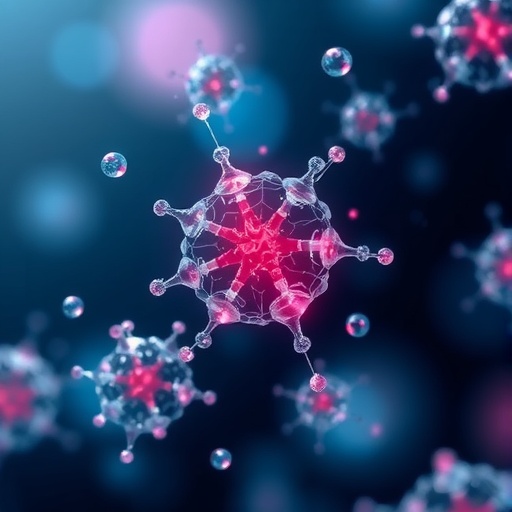In the relentless quest to enhance biosensing technologies, researchers have long grappled with the challenges posed by environmental interference, particularly the destabilizing effects of water. Now, a groundbreaking study heralds a transformative leap forward—introducing water-insensitive down-shifting nanoparticles engineered specifically for sensitive and robust biosensing applications. This innovation promises to overcome longstanding barriers in the detection and analysis of biological molecules, potentially revolutionizing diagnostics, environmental monitoring, and bioengineering.
Biosensors rely heavily on the interaction between biological elements and transducers that convert these interactions into measurable signals. Traditionally, fluorescent nanoparticles have been employed due to their exceptional sensitivity and specificity. However, their performance has been significantly hindered by water’s quenching effects, leading to diminished fluorescence intensity and degraded sensing fidelity. The novel class of nanoparticles presented in this research demonstrates remarkable resilience against water-induced quenching, thereby preserving sharp optical signals even under aqueous conditions.
At the heart of this advancement lies the concept of down-shifting luminescence—a photophysical process where incident high-energy photons are absorbed and re-emitted at lower energy wavelengths. This phenomenon not only optimizes signal detection by minimizing background noise but also fine-tunes the emission spectra for compatibility with diverse sensing platforms. The water-insensitive down-shifting nanoparticles preserve these desirable characteristics while exhibiting enhanced stability and brightness in biological environments brimming with water molecules.
Central to the development of these nanoparticles is the meticulous engineering of their surface chemistry and core-shell structures. By strategically designing multi-layered architectures, the researchers effectively shield the luminescent core from water molecules that would typically quench its emission. These modifications entail the incorporation of hydrophobic ligands and robust protective coatings, which collectively establish a barrier that simultaneously promotes optical performance and chemical stability.
Furthermore, the researchers harnessed advanced synthesis techniques to control particle size, crystallinity, and dopant distribution—a trifecta crucial to optimizing photophysical properties. Nanoscale precision in particle fabrication ensures efficient light absorption and emission while minimizing non-radiative decay pathways. Such rigorous control over material parameters empowers these nanoparticles to serve as highly sensitive probes, capable of detecting biomolecules at exceedingly low concentrations.
The research also delves into the photostability of these nanoparticles, a metric vital for reliable long-term biosensing. Unlike conventional luminescent materials that suffer photobleaching upon prolonged excitation, the developed nanoparticles maintain consistent emission intensity over extended periods. This characteristic is particularly advantageous for continuous monitoring applications, where signal reliability is paramount.
Integrating these water-insensitive down-shifting nanoparticles into biosensing devices facilitates real-time detection of biomolecules such as proteins, nucleic acids, and small metabolites with unprecedented sensitivity. The optical signals generated by the nanoparticles can be precisely correlated to analyte concentrations, enabling quantitative analyses with minimal sample preparation. Such capacity opens doors to rapid diagnostics, personalized medicine, and environmental pollutant tracking.
To validate their potential, the researchers conducted extensive biosensing assays under physiologically relevant aqueous conditions. The nanoparticles demonstrated superior performance compared to existing fluorescent probes, maintaining consistent luminescence irrespective of water content variations. This robustness points towards their suitability for deployment in complex biological fluids, including blood serum, saliva, and interstitial fluids—contexts where water-insensitivity is indispensable.
The impact of this research transcends traditional biosensing realms. The high signal-to-noise ratio, combined with the nanoparticles’ stable and tunable emission spectra, positions them as promising candidates for implementing multiplexed sensing arrays. This capability allows simultaneous detection of multiple target analytes, dramatically enhancing throughput and information density in biomedical diagnostics and environmental assessments.
Additional advantages stem from the biocompatible and customizable surface functionalization of nanoparticles, which assures selective binding to target molecules. By conjugating specific antibodies, oligonucleotides, or aptamers onto the nanoparticle surfaces, researchers can tailor sensors to detect virtually any biomarker with exceptional accuracy and speed. This modularity amplifies the relevance of the technology across diverse scientific and clinical disciplines.
Moreover, the underlying physics governing down-shifting emission coupled with strategic material engineering introduces a new paradigm in nanoparticle design. The approach augments photon utilization efficiency, ensuring that the maximum number of absorbed photons contribute to the detectable emission. This efficiency not only bolsters sensitivity but also minimizes photodamage to biological samples, a critical concern in live-cell imaging and in vivo sensing.
Environmental stability is another hallmark of this innovation. The nanoparticles withstand varied pH levels, ionic strengths, and temperatures commonly encountered in biological and environmental samples. This comprehensive robustness reduces the need for complex sample conditioning, simplifying workflow and making point-of-care applications more feasible in resource-limited settings.
Looking to the future, the integration of these water-insensitive down-shifting nanoparticles into portable sensing platforms and microfluidic devices holds exciting potential. The compactness and high sensitivity they offer align with the increasing demand for decentralizing diagnostics and environmental monitoring, enabling rapid decision-making and timely interventions across healthcare, agriculture, and pollution control.
While the current study establishes a solid foundation, ongoing research is expected to explore further refinements in nanoparticle composition, emission tunability across the visible and near-infrared spectrum, and scalable manufacturing processes. These advancements will aim to expedite translation from laboratory demonstrations to widespread commercial applications, ushering a new era in the field of sensitive biosensing.
In sum, this pioneering work on water-insensitive down-shifting nanoparticles signifies a critical stride in overcoming one of biosensing’s most pervasive challenges—maintaining signal integrity in aqueous environments. By fusing nanoscale engineering, photophysics, and surface chemistry, the researchers have crafted a versatile platform poised to redefine how biological detection is performed. As these nanoparticles transition from experimental validation to practical devices, their influence promises to be profound and far-reaching.
Subject of Research:
Water-insensitive down-shifting nanoparticles developed for enhanced and robust biosensing applications in aqueous biological environments.
Article Title:
Water-insensitive down-shifting nanoparticles for sensitive biosensing
Article References:
Ming, J., Hu, S. & Zhang, F. Water-insensitive down-shifting nanoparticles for sensitive biosensing. Light Sci Appl 14, 307 (2025). https://doi.org/10.1038/s41377-025-01976-x
Image Credits:
AI Generated
Tags: bioengineering applicationsbiosensing technology advancementsdiagnostic technology improvementsdown-shifting luminescence applicationsenhanced biosensor sensitivityenvironmental monitoring advancementsfluorescent nanoparticles challengesmolecular detection innovationsoptical signal preservation techniquesrobust biosensing solutionswater interference in biosensingwater-resistant nanoparticles






